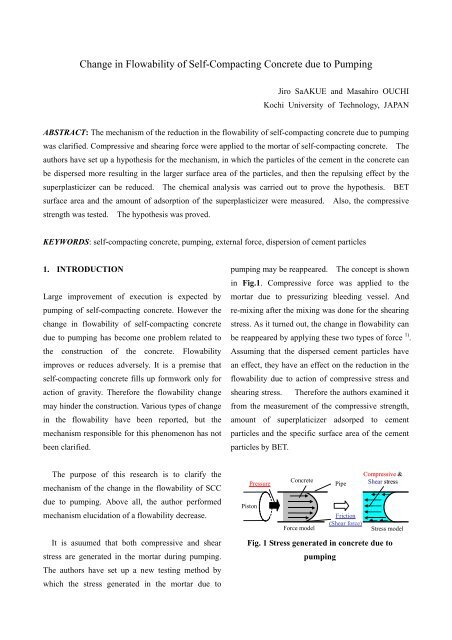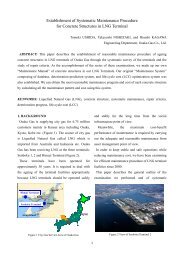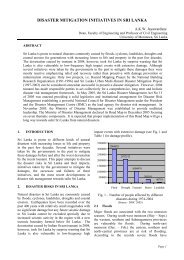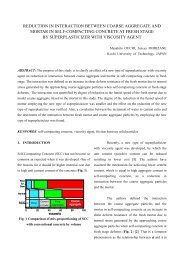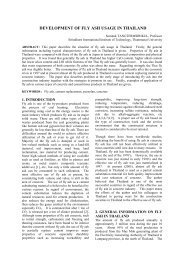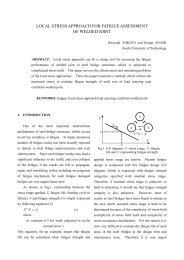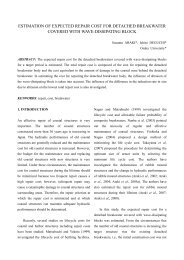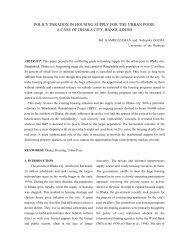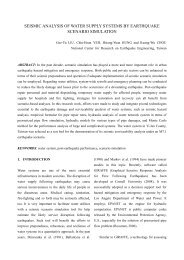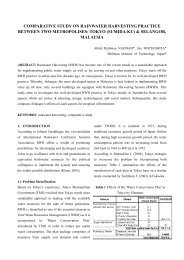Change in Flowability of Self-Compacting Concrete due to Pumping
Change in Flowability of Self-Compacting Concrete due to Pumping
Change in Flowability of Self-Compacting Concrete due to Pumping
You also want an ePaper? Increase the reach of your titles
YUMPU automatically turns print PDFs into web optimized ePapers that Google loves.
<strong>Change</strong> <strong>in</strong> <strong>Flowability</strong> <strong>of</strong> <strong>Self</strong>-Compact<strong>in</strong>g <strong>Concrete</strong> <strong>due</strong> <strong>to</strong> Pump<strong>in</strong>g<br />
Jiro SaAKUE and Masahiro OUCHI<br />
Kochi University <strong>of</strong> Technology, JAPAN<br />
ABSTRACT: The mechanism <strong>of</strong> the reduction <strong>in</strong> the flowability <strong>of</strong> self-compact<strong>in</strong>g concrete <strong>due</strong> <strong>to</strong> pump<strong>in</strong>g<br />
was clarified. Compressive and shear<strong>in</strong>g force were applied <strong>to</strong> the mortar <strong>of</strong> self-compact<strong>in</strong>g concrete. The<br />
authors have set up a hypothesis for the mechanism, <strong>in</strong> which the particles <strong>of</strong> the cement <strong>in</strong> the concrete can<br />
be dispersed more result<strong>in</strong>g <strong>in</strong> the larger surface area <strong>of</strong> the particles, and then the repuls<strong>in</strong>g effect by the<br />
superplasticizer can be reduced. The chemical analysis was carried out <strong>to</strong> prove the hypothesis. BET<br />
surface area and the amount <strong>of</strong> adsorption <strong>of</strong> the superplasticizer were measured. Also, the compressive<br />
strength was tested. The hypothesis was proved.<br />
KEYWORDS: self-compact<strong>in</strong>g concrete, pump<strong>in</strong>g, external force, dispersion <strong>of</strong> cement particles<br />
1. INTRODUCTION<br />
Large improvement <strong>of</strong> execution is expected by<br />
pump<strong>in</strong>g <strong>of</strong> self-compact<strong>in</strong>g concrete. However the<br />
change <strong>in</strong> flowability <strong>of</strong> self-compact<strong>in</strong>g concrete<br />
<strong>due</strong> <strong>to</strong> pump<strong>in</strong>g has become one problem related <strong>to</strong><br />
the construction <strong>of</strong> the concrete. <strong>Flowability</strong><br />
improves or reduces adversely. It is a premise that<br />
self-compact<strong>in</strong>g concrete fills up formwork only for<br />
action <strong>of</strong> gravity. Therefore the flowability change<br />
may h<strong>in</strong>der the construction. Various types <strong>of</strong> change<br />
<strong>in</strong> the flowability have been reported, but the<br />
mechanism responsible for this phenomenon has not<br />
been clarified.<br />
pump<strong>in</strong>g may be reappeared. The concept is shown<br />
<strong>in</strong> Fig.1. Compressive force was applied <strong>to</strong> the<br />
mortar <strong>due</strong> <strong>to</strong> pressuriz<strong>in</strong>g bleed<strong>in</strong>g vessel. And<br />
re-mix<strong>in</strong>g after the mix<strong>in</strong>g was done for the shear<strong>in</strong>g<br />
stress. As it turned out, the change <strong>in</strong> flowability can<br />
be reappeared by apply<strong>in</strong>g these two types <strong>of</strong> force 1) .<br />
Assum<strong>in</strong>g that the dispersed cement particles have<br />
an effect, they have an effect on the reduction <strong>in</strong> the<br />
flowability <strong>due</strong> <strong>to</strong> action <strong>of</strong> compressive stress and<br />
shear<strong>in</strong>g stress. Therefore the authors exam<strong>in</strong>ed it<br />
from the measurement <strong>of</strong> the compressive strength,<br />
amount <strong>of</strong> superplaticizer adsorped <strong>to</strong> cement<br />
particles and the specific surface area <strong>of</strong> the cement<br />
particles by BET.<br />
The purpose <strong>of</strong> this research is <strong>to</strong> clarify the<br />
mechanism <strong>of</strong> the change <strong>in</strong> the flowability <strong>of</strong> SCC<br />
<strong>due</strong> <strong>to</strong> pump<strong>in</strong>g. Above all, the author performed<br />
mechanism elucidation <strong>of</strong> a flowability decrease.<br />
It is asuumed that both compressive and shear<br />
stress are generated <strong>in</strong> the mortar dur<strong>in</strong>g pump<strong>in</strong>g.<br />
The authors have set up a new test<strong>in</strong>g method by<br />
which the stress generated <strong>in</strong> the mortar <strong>due</strong> <strong>to</strong><br />
Pis<strong>to</strong>n<br />
Pressure<br />
<strong>Concrete</strong><br />
Force model<br />
Pipe<br />
Friction<br />
(Shear force)<br />
Compressive &<br />
Shear stress<br />
Stress model<br />
Fig. 1 Stress generated <strong>in</strong> concrete <strong>due</strong> <strong>to</strong><br />
pump<strong>in</strong>g
Table 1 Mix proportions<br />
No.<br />
W/C s/m SP/C Unit weight (kg/m 3 )<br />
(%) (%) (%) Water Cement F<strong>in</strong>e aggregate SP<br />
A-1 28.6 45 0.78 264 922 1224 7.19<br />
A-2 28.6 45 0.85 264 922 1224 8.76<br />
B-1 29.8 45 0.78 269 904 1224 7.05<br />
C-1 27.0 45 0.78 256 947 1224 7.39<br />
Table 2 Materials<br />
Material<br />
Specifications<br />
Low-heat portland<br />
Specify gravity: 3.22<br />
cement<br />
Specify gravity: 2.72;<br />
Crushed sand<br />
FM:3.00<br />
Superplasticizer Polycarboxylate type<br />
2. METHODOLOGY<br />
2.1 Materials and mix proportions<br />
The mix-proportion<strong>in</strong>g <strong>of</strong> the mortar is shown <strong>in</strong><br />
Table 1 and the materials are shown <strong>in</strong> Table 2. The<br />
practical mix-proportion<strong>in</strong>g <strong>of</strong> self-compact<strong>in</strong>g<br />
concrete’s mortar was assumed.<br />
2.2 Apply <strong>of</strong> external force <strong>to</strong> mortar<br />
The pressure <strong>to</strong> the SCC's mortar was 8.8 MPa with the<br />
pressuriz<strong>in</strong>g bleed<strong>in</strong>g vessel <strong>to</strong> generate compressive<br />
stress <strong>in</strong> the mortar. Also, re-mix<strong>in</strong>g speed was 125<br />
rpm on the axis and paddle revolved at 285 rpm <strong>to</strong><br />
generate shear stress <strong>in</strong> the mortar. The duration <strong>of</strong> the<br />
pressure and re-mix<strong>in</strong>g was one, three or five m<strong>in</strong>utes<br />
respectively.<br />
divided <strong>in</strong><strong>to</strong> two portions. One portion was subjected<br />
<strong>to</strong> pressurization test and re-mix<strong>in</strong>g for compressive<br />
and shear stress. Another portion was kept still.<br />
After that, flow and funnel tests were carried out for<br />
each portion <strong>of</strong> the mortar. These tests were carried<br />
out at almost the same time so that the <strong>in</strong>fluence <strong>of</strong><br />
the time may be m<strong>in</strong>imized. And, the flowability <strong>of</strong><br />
the two pars <strong>of</strong> mortar was compared. The <strong>in</strong>fluence<br />
<strong>of</strong> the external force was evaluated by compar<strong>in</strong>g the<br />
two pairs <strong>of</strong> flowability test results.<br />
(1) Deformability Gm and Viscosity Rm<br />
The mortar flow employed the mortar flow corn<br />
(Fig. 2). And the deformability was obta<strong>in</strong>ed with (1).<br />
The discharg<strong>in</strong>g time through funnel was measured<br />
us<strong>in</strong>g the funnel test (Fig. 3). And the <strong>in</strong>dex for the<br />
viscosity was obta<strong>in</strong>ed with (2). The evaluation <strong>of</strong><br />
flowability used two <strong>in</strong>dexes 3) .<br />
70mm<br />
60mm<br />
d 1<br />
d 2<br />
d 0<br />
=100mm<br />
Fig. 2 Mortar flow test<br />
2.3 Test method for flowability <strong>of</strong> mortar<br />
First, mortar was mixed. The mix<strong>in</strong>g speed was 125<br />
rpm on the axis and paddle revolved at 285 rpm.<br />
Next, the mortar was kept still afterwards at up <strong>to</strong> 30<br />
m<strong>in</strong>utes assum<strong>in</strong>g the time between the batch<strong>in</strong>g<br />
plant and the cast<strong>in</strong>g site. After that the mortar was
30mm<br />
270mm<br />
240mm<br />
30mm<br />
60mm<br />
Fig. 3. Mortar funnel test 2)<br />
Gm = (d 1 *d 2 -d 2 2<br />
o )/d o (1)<br />
Rm = 10/t (2)<br />
Fig. 4 Molecular structure <strong>of</strong> superplasticizer<br />
d 1 ,d 2 : diameter <strong>of</strong> mortar flow (mm)<br />
d o : diameter <strong>of</strong> flow corn (mm)<br />
t: discharg<strong>in</strong>g time through funnel (sec)<br />
(2) Compressive strength test<br />
The compressive strength was tested for the<br />
cyl<strong>in</strong>der <strong>of</strong> φ 50 * 100 mm at the age <strong>of</strong> 7 days <strong>in</strong> the<br />
standard cur<strong>in</strong>g method.<br />
(4) Specific surface area <strong>of</strong> cement<br />
The specific surface area <strong>of</strong> the cement was<br />
measured by BET method. Firstly hydration reaction<br />
<strong>of</strong> mortar was s<strong>to</strong>pped by the ace<strong>to</strong>ne. Secondly it<br />
was dried <strong>in</strong> at 40 degrees centigrade for 24 hours.<br />
F<strong>in</strong>ally cement <strong>of</strong> less than 75mm diameter was<br />
sampled. The specific surface area was measured for<br />
A-1 and A-2.<br />
(3) Amount <strong>of</strong> superplasticizer adsorbed <strong>to</strong><br />
cement<br />
Chemical structure <strong>of</strong> superplasticizer is shown <strong>in</strong><br />
Fig. 4. The amount <strong>of</strong> superplasticizer adsorbed <strong>to</strong><br />
cement was measured for per cement 1g by the<br />
measurement <strong>of</strong> the amount <strong>of</strong> carbon <strong>in</strong>cluded <strong>in</strong><br />
the fluid phase <strong>of</strong> the mortar. The fluid phase <strong>of</strong><br />
mortar was triggered with the gravity <strong>of</strong> about 7000<br />
G for five m<strong>in</strong>utes with a centrifuge <strong>to</strong> extract it, and<br />
it was measured by the <strong>to</strong>tal organic carbon<br />
measurement.<br />
3 EXPERIMENTAL RESULTS<br />
3.1 Influence on flowability <strong>due</strong> <strong>to</strong> external force<br />
The change <strong>in</strong> the flowability <strong>of</strong> the mortar <strong>due</strong> <strong>to</strong><br />
the external force is shown <strong>in</strong> Fig. 5 <strong>to</strong> 7. The<br />
changes <strong>in</strong> the flowability <strong>due</strong> <strong>to</strong> the external force<br />
were different by the dosage <strong>of</strong> SP or the unit water<br />
content <strong>of</strong> the mortar.
Rm<br />
2.2<br />
2.0<br />
1.8<br />
1.6<br />
1.4<br />
1.2<br />
1.0<br />
0.8<br />
0.6<br />
0.4<br />
0.2<br />
0.0<br />
5 m<strong>in</strong><br />
5 m<strong>in</strong><br />
3 m<strong>in</strong><br />
3 m<strong>in</strong><br />
1 m<strong>in</strong><br />
0.0 2.0 4.0 6.0 8.0<br />
Gm<br />
External force<br />
1 m<strong>in</strong>ute<br />
still<br />
A-1 A-2<br />
The relationship between the duration <strong>of</strong> apply<strong>in</strong>g<br />
the external force and the rate <strong>of</strong> change <strong>in</strong> the<br />
deformability is shown <strong>in</strong> (Fig. 8). The deformability<br />
was reduced <strong>due</strong> <strong>to</strong> the external force. When the<br />
water <strong>to</strong> cement ratio or the dosage <strong>of</strong> SP was high,<br />
the reduction <strong>in</strong> the deformability was small. It was<br />
found from the result that when Gm was large, the<br />
<strong>in</strong>fluence <strong>of</strong> external force was small. If the viscosity<br />
before apply<strong>in</strong>g external force was low, the change<br />
<strong>in</strong> Gm was also small.<br />
Rm<br />
Rm<br />
Fig. 5 <strong>Change</strong> <strong>in</strong> flowability <strong>due</strong> <strong>to</strong> external<br />
force: difference <strong>in</strong> SP dosage<br />
2.2<br />
2.0<br />
1.8<br />
1.6<br />
1.4<br />
1.2<br />
1.0<br />
0.8<br />
0.6<br />
0.4<br />
0.2<br />
0.0<br />
2.2<br />
2.0<br />
1.8<br />
1.6<br />
1.4<br />
1.2<br />
1.0<br />
0.8<br />
0.6<br />
0.4<br />
0.2<br />
0.0<br />
5 m<strong>in</strong><br />
5 m<strong>in</strong><br />
3 m<strong>in</strong><br />
1 m<strong>in</strong><br />
0.0 2.0 4.0 6.0 8.0<br />
5 m<strong>in</strong><br />
1 m<strong>in</strong><br />
3 and 5 m<strong>in</strong><br />
3 m<strong>in</strong><br />
Gm<br />
1 m<strong>in</strong><br />
3 m<strong>in</strong><br />
1 m<strong>in</strong><br />
still<br />
0.0 2.0 4.0 6.0 8.0<br />
Gm<br />
still<br />
A-1 B-1<br />
Fig. 6 <strong>Change</strong> <strong>in</strong> flowability <strong>due</strong> <strong>to</strong> external<br />
force: difference <strong>in</strong> water <strong>to</strong> cement ratio<br />
still<br />
A-1 C-1<br />
Fig. 7 <strong>Change</strong> <strong>in</strong> flowability <strong>due</strong> <strong>to</strong> external<br />
force: difference <strong>in</strong> water <strong>to</strong> cement ratio<br />
The rate <strong>of</strong> change <strong>of</strong> Rm is shown <strong>in</strong> Fig. 9. Rm<br />
<strong>of</strong> C-1 was reduced remarkably after one m<strong>in</strong>ute as<br />
well as Gm.<br />
.<br />
Rate <strong>of</strong> change <strong>of</strong> Gm (%)<br />
Rate <strong>of</strong> change <strong>of</strong> Rm (%)<br />
20<br />
0<br />
-20<br />
-40<br />
-60<br />
-80<br />
-100<br />
60<br />
50<br />
40<br />
30<br />
20<br />
10<br />
0<br />
-10<br />
-20<br />
-30<br />
-40<br />
A-1 A-2<br />
B-1 C-1<br />
0 1 2 3 4 5 6<br />
Action time <strong>of</strong> external force (m<strong>in</strong>)<br />
Fig. 8 Rate <strong>of</strong> change <strong>in</strong> deformability <strong>due</strong> <strong>to</strong><br />
external force<br />
A-1 A-2<br />
B-1 C-1<br />
0 1 2 3 4 5 6<br />
Action time <strong>of</strong> external force (m<strong>in</strong>)<br />
Fig. 9 Rate <strong>of</strong> change <strong>in</strong> viscosity <strong>due</strong> <strong>to</strong><br />
external force
3.2 Influence on compressive strength<br />
The relationship between the duration <strong>of</strong> apply<strong>in</strong>g<br />
the external force and the compressive strength is<br />
shown (Fig. 10). The compressive strength was<br />
<strong>in</strong>creased with the <strong>in</strong>crease <strong>of</strong> the duration <strong>of</strong><br />
apply<strong>in</strong>g the external force despite <strong>of</strong> the type <strong>of</strong> the<br />
mix-proportion<strong>in</strong>g. It is assumed that the external<br />
force dispersed the coagulated cement particles and<br />
it promoted the hydarion <strong>of</strong> the cement particles,<br />
which resulted <strong>in</strong> the higher compressive strength 4) .<br />
SP adsorbed amount (mg/g)<br />
6.5<br />
A-1 A-2<br />
6.0<br />
B-1<br />
5.5<br />
5.0<br />
4.5<br />
0 1 2 3 4 5 6<br />
Action time <strong>of</strong> external force (m<strong>in</strong>)<br />
Fig. 11 External force <strong>in</strong>creased<br />
adsorption <strong>of</strong> superplasticizer <strong>to</strong> cement<br />
Also, the specific surface area <strong>of</strong> cement particle<br />
Compressive strength (N/mm 2 )<br />
75<br />
73<br />
71<br />
69<br />
67<br />
65<br />
63<br />
61<br />
59<br />
57<br />
55<br />
A-1 A-2<br />
B-1 C-1<br />
0 1 2 3 4 5 6<br />
Action time <strong>of</strong> external force (m<strong>in</strong>)<br />
Fig. 10 External force <strong>in</strong>creased<br />
compressive strength<br />
3.3 Specific surface area <strong>of</strong> a cement particle <strong>due</strong><br />
<strong>to</strong> action <strong>of</strong> external force<br />
The external force <strong>in</strong>creased the amount <strong>of</strong><br />
superplasticizer adsorbed <strong>to</strong> cement (Fig. 11).<br />
However, the deformability was reduced although<br />
the deformability was reduced.<br />
was measured for A-1 and A-2 (Fig 12) by BET<br />
method. The specific surface were <strong>in</strong>creased greatly<br />
<strong>due</strong> <strong>to</strong> the external force. It was found from the<br />
result that the cement particles were dispersed <strong>due</strong> <strong>to</strong><br />
the external force. That is, it is possible that the<br />
dispersion <strong>of</strong> cement particles <strong>in</strong>fluenced the change<br />
<strong>in</strong> the flowability.<br />
2.0<br />
Specific surface area (m 2 /g)<br />
1.8<br />
1.6<br />
1.4<br />
1.2<br />
A-1 A-2<br />
1.0<br />
0 1 2 3 4 5 6<br />
Action time <strong>of</strong> external force (m<strong>in</strong>)<br />
Fig. 12 External force <strong>in</strong>creased surface<br />
area <strong>of</strong> cement particles<br />
The relationship between the amount <strong>of</strong><br />
superplasticizer adsorped <strong>to</strong> the cement particles and<br />
the specific surface area was exam<strong>in</strong>ed (Fig. 13).<br />
Increased <strong>to</strong>tal surface area <strong>of</strong> the cement particles
educed the amount <strong>of</strong> the superplasticizer adsorbed<br />
<strong>to</strong> cement particles per unit surface area. It was<br />
concluded that dispersion <strong>of</strong> cement particles<br />
decreased the effect <strong>of</strong> superplasticizer.<br />
Accord<strong>in</strong>g <strong>to</strong> the previous research, the reduced<br />
amount <strong>of</strong> superplasticizer adsorped <strong>to</strong> cement per<br />
unit surface also reduced the flowablity <strong>of</strong> the mortar<br />
5) . ,which corresponded <strong>to</strong> the result <strong>in</strong> this study.<br />
(3) It was concluded that dispersion <strong>of</strong> cement<br />
particles decreased the effect <strong>of</strong> superplasticizer <strong>due</strong><br />
<strong>to</strong> the decrease <strong>in</strong> the amount <strong>of</strong> superplasticizer<br />
adsorbed <strong>to</strong> cement particles per unit surface area<br />
and that it resulted <strong>in</strong> the reduction <strong>in</strong> the flowability<br />
<strong>of</strong> mortar <strong>in</strong> SCC.<br />
5 REFERENCES<br />
Rate <strong>of</strong> change <strong>of</strong> SP adsorption<br />
amount per surface area (%)<br />
0<br />
-5<br />
-10<br />
-15<br />
-20<br />
-25<br />
-30<br />
-35<br />
-40<br />
4 CONCLUSIONS<br />
A-1 A-2<br />
0 20 40 60 80<br />
Rate <strong>of</strong> change <strong>of</strong> specific surface area (%)<br />
Fig. 13 Reduction <strong>in</strong> adsorption <strong>of</strong><br />
superplaticizer <strong>to</strong> unit surface area <strong>of</strong><br />
cement<br />
The purpose <strong>of</strong> this research is <strong>to</strong> clarify the<br />
mechanism <strong>of</strong> the change <strong>in</strong> the flowability <strong>of</strong> SCC<br />
<strong>due</strong> <strong>to</strong> pump<strong>in</strong>g. The results were summarized as<br />
follows:<br />
1) Sakue J, Ouchi M: Reappearance <strong>of</strong> <strong>Change</strong> <strong>of</strong><br />
<strong>Flowability</strong> <strong>of</strong> <strong>Self</strong>-Compact<strong>in</strong>g <strong>Concrete</strong> <strong>due</strong> <strong>to</strong><br />
Pump<strong>in</strong>g, fib, 2006<br />
2) Okamura H, Maekawa H, Ozawa K: High<br />
performance concrete, Gihodoshuppan, 1993.9<br />
3) Ouchi M, Hib<strong>in</strong>o M, Sugamata T, Okamura H:<br />
Quantitative evaluation method for the effect <strong>of</strong><br />
superplasticizer <strong>in</strong> self-compact<strong>in</strong>g concrete,<br />
Proceed<strong>in</strong>gs <strong>of</strong> the Japan <strong>Concrete</strong> Institute,<br />
Vol.21, No.1, pp.129-134, 1998<br />
4) Fukaya Y, Tuyuki N: Cement <strong>Concrete</strong> Materials<br />
Science, The House <strong>of</strong> technical book, pp.68-99,<br />
2003.10<br />
5) Sugamata T, Edamatu Y, Ouchi M: Quantitative<br />
evaluation for reta<strong>in</strong><strong>in</strong>g <strong>in</strong> diepsers<strong>in</strong>g effect by<br />
superplasticizer, Proceed<strong>in</strong>gs <strong>of</strong> the Japan<br />
<strong>Concrete</strong> Institute, Vol.22, No.2, pp.163-168, 2000<br />
(1) If deformability <strong>of</strong> the mortar was high, the<br />
<strong>in</strong>fluence <strong>of</strong> the external force was reduced.<br />
(2) Compressive strength <strong>of</strong> the mortar, the amount <strong>of</strong><br />
superplasticizer adsorped <strong>to</strong> cement and the BET<br />
surface area were measured. The dispersion <strong>of</strong><br />
cement particles was <strong>in</strong>creased <strong>due</strong> <strong>to</strong> the external<br />
force.


